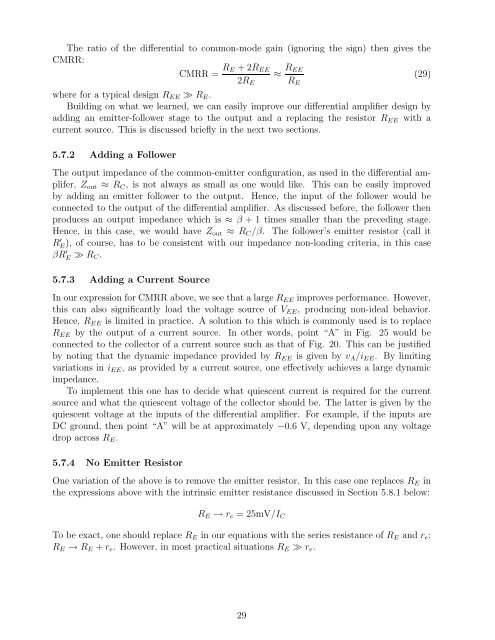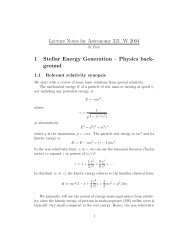Lecture Notes for Analog Electronics - The Electronic Universe ...
Lecture Notes for Analog Electronics - The Electronic Universe ...
Lecture Notes for Analog Electronics - The Electronic Universe ...
You also want an ePaper? Increase the reach of your titles
YUMPU automatically turns print PDFs into web optimized ePapers that Google loves.
<strong>The</strong> ratio of the differential to common-mode gain (ignoring the sign) then gives the<br />
CMRR:<br />
CMRR = RE +2REE<br />
2RE<br />
≈ REE<br />
RE<br />
where <strong>for</strong> a typical design REE ≫ RE.<br />
Building on what we learned, we can easily improve our differential amplifier design by<br />
adding an emitter-follower stage to the output and a replacing the resistor REE with a<br />
current source. This is discussed briefly in the next two sections.<br />
5.7.2 Adding a Follower<br />
<strong>The</strong> output impedance of the common-emitter configuration, as used in the differential amplifer,<br />
Zout ≈ RC, is not always as small as one would like. This can be easily improved<br />
by adding an emitter follower to the output. Hence, the input of the follower would be<br />
connected to the output of the differential amplifier. As discussed be<strong>for</strong>e, the follower then<br />
produces an output impedance which is ≈ β + 1 times smaller than the preceding stage.<br />
Hence, in this case, we would have Zout ≈ RC/β. <strong>The</strong> follower’s emitter resistor (call it<br />
R ′ E), of course, has to be consistent with our impedance non-loading criteria, in this case<br />
βR ′ E ≫ RC.<br />
5.7.3 Adding a Current Source<br />
In our expression <strong>for</strong> CMRR above, we see that a large REE improves per<strong>for</strong>mance. However,<br />
this can also significantly load the voltage source of VEE, producing non-ideal behavior.<br />
Hence, REE is limited in practice. A solution to this which is commonly used is to replace<br />
REE by the output of a current source. In other words, point “A” in Fig. 25 would be<br />
connected to the collector of a current source such as that of Fig. 20. This can be justified<br />
by noting that the dynamic impedance provided by REE is given by vA/iEE. By limiting<br />
variations in iEE, as provided by a current source, one effectively achieves a large dynamic<br />
impedance.<br />
To implement this one has to decide what quiescent current is required <strong>for</strong> the current<br />
source and what the quiescent voltage of the collector should be. <strong>The</strong> latter is given by the<br />
quiescent voltage at the inputs of the differential amplifier. For example, if the inputs are<br />
DC ground, then point “A” will be at approximately −0.6 V, depending upon any voltage<br />
drop across RE.<br />
5.7.4 No Emitter Resistor<br />
One variation of the above is to remove the emitter resistor. In this case one replaces RE in<br />
the expressions above with the intrinsic emitter resistance discussed in Section 5.8.1 below:<br />
RE → re = 25mV/IC<br />
To be exact, one should replace RE in our equations with the series resistance of RE and re:<br />
RE → RE + re. However, in most practical situations RE ≫ re.<br />
29<br />
(29)













